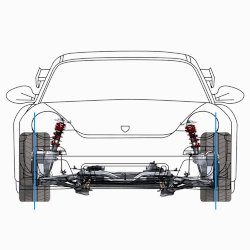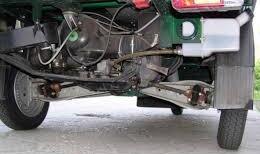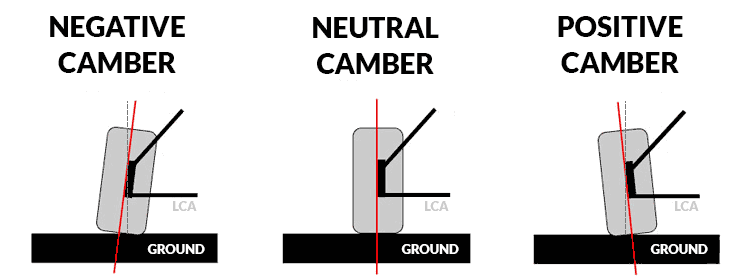Caster and Camber Angles: The Unsung Heroes of Your Car's Handling
Published On 15/7/2024, 7:16:52 am Author Uttkarsh SinghDiscover how caster and camber angles affect your car's handling and performance. Learn about the difference between positive and negative angles, their impact on tire wear, and how to optimize them for a smoother, safer ride. Understand the science behind those tilted wheels on racecars and improve your driving experience.

If you have seen a Piaggio auto or a racecar, you might have noticed the unusual tilt of their wheels. This tilt is not just an aesthetic feature but plays a crucial role in the vehicle's performance, handling, and stability. The angles at which the wheels are tilted are referred to as caster and camber angles, two essential aspects of wheel alignment.

Camber Angle
The camber angle refers to the tilt of the wheels from the vertical axis when viewed from the front or rear of the vehicle. There are three types of camber angles: positive, negative, and neutral (or zero).

Negative Camber: In contrast, negative camber occurs when the top of the wheels tilt inward towards the center of the vehicle. This is commonly seen in performance and race cars. Negative camber increases the contact patch of the tire during cornering, improving grip and handling. It helps the tire maintain more uniform contact with the road surface, particularly during high-speed turns, providing better traction and control.
Neutral Camber: When the wheels are perfectly vertical, they are said to have neutral or zero camber. This setup aims to provide the most even tire wear and stable straight-line driving, often seen in everyday road cars for balanced performance.
Positive Camber: When the top of the wheels tilt outward from the center of the vehicle, it is called positive camber. This angle can be found in some older cars and vehicles designed for heavy loads, as it helps in stabilizing the vehicle and reducing the effort required to steer.
Caster Angle
The caster angle is the angle created by the steering pivot axis when viewed from the side of the vehicle. It affects the vehicle's steering stability, cornering, and the effort required to turn the steering wheel. Like camber, caster angles can be positive or negative.

Negative Caster: Negative caster, where the steering axis tilts forward, is less common in modern vehicles but can be found in some older designs and specific applications. Negative caster can make the steering feel lighter but often results in reduced straight-line stability and less effective self-centering of the steering wheel.
Zero Caster: Neutral caster, also known as zero caster, occurs when the steering pivot axis is perfectly vertical, meaning there is no tilt forward or backward when viewed from the side of the vehicle. In this configuration, the steering axis forms a 90-degree angle with the ground.
Importance of Proper Alignment
Proper alignment of caster and camber angles is crucial for vehicle performance, safety, and tire longevity. These angles influence how a vehicle handles, how evenly the tires wear, and the overall stability of the vehicle. Incorrect angles can lead to various issues such as uneven tire wear, poor handling, and increased stress on suspension components. Regular wheel alignment checks and adjustments ensure that the vehicle operates as intended, providing optimal handling characteristics and maximizing tire life.
Causes of Misalignment
Road Conditions: Driving on rough or uneven roads, hitting potholes, curbs, or other obstacles can cause the suspension components to shift, leading to changes in caster and camber angles.
Wear and Tear: Over time, suspension components like bushings, ball joints, and tie rods can wear out or become loose, affecting the alignment angles.
Accidents: Even minor collisions can cause significant misalignment in the suspension geometry, necessitating a thorough inspection and realignment.
Modifications: Installing aftermarket parts or changing the ride height of the vehicle can alter the factory alignment settings, requiring a professional adjustment.
Effects of Misalignment
Uneven Tire Wear: Misaligned wheels cause the tires to wear unevenly, often resulting in premature tire replacement and increased costs. For example, negative camber can cause the inside edges of the tires to wear out faster than the outside edges.
Poor Handling: Incorrect camber and caster angles can make the vehicle harder to control, especially during cornering or at high speeds. This can lead to unsafe driving conditions and increase the risk of accidents.
Increased Suspension Stress: When alignment angles are off, it places additional stress on suspension components, leading to accelerated wear and potential failure of parts like shocks, struts, and control arms.
Fixing Misalignment
Fixing misalignment involves a combination of regular inspections, professional alignment services, and the replacement of worn parts. Regularly scheduled wheel alignment checks, typically conducted during routine maintenance or when new tires are installed, help detect and correct alignment issues before they escalate. Professional alignment services use specialized equipment to measure and adjust the caster and camber angles to the manufacturer’s specifications, ensuring that the wheels are perpendicular to the ground and parallel to each other. If suspension components like bushings, ball joints, or tie rods are worn or damaged, they should be replaced prior to alignment to ensure the settings remain stable and accurate. Additionally, for vehicles that have been modified or are used in competitive driving, installing aftermarket adjustable control arms or camber kits allows for precise adjustments to meet specific performance requirements.
















